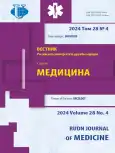New approaches to quality control of drugs from the group of branched polymers on the example of dextran
- 作者: Marchenkova L.A.1, Safdari A.1, Uspenskaya E.V.1
-
隶属关系:
- RUDN University
- 期: 卷 28, 编号 4 (2024): ONCOLOGY
- 页面: 537-547
- 栏目: PHARMACOLOGY
- URL: https://journal-vniispk.ru/2313-0245/article/view/319743
- DOI: https://doi.org/10.22363/2313-0245-2024-28-4-537-547
- EDN: https://elibrary.ru/HFDTYZ
- ID: 319743
如何引用文章
全文:
详细
Relevance. Colloidal blood substitutes — polyglukins — have been used in infusion therapy for 70 years and are widely represented in modern pharmaceutical regulatory documentation. Glucose polymer with a (1→6) glycosidic linkages (dextran), as the main active pharmaceutical ingredient of polyglukins, has exceptional properties, such as long-term circulation in the bloodstream, inertness, volemic, detoxification, and antithrombotic effects. Quality authentication control of polyglukins usually includes FT-IR spectroscopy, while systems of polymeric micelles require characterization of dispersion and the electrophoretic properties that are in unambiguous correspondence with their biological activity. The aim of the study was to develop new approaches based on laser scattering methods to identify polymer-based blood substitute drugs to complement existing regulatory documentation, and assess their biological activity using the Spirotox method. Materials and Methods. Reopolyglukin (Rpg) — an aqueous solution of dextran with a molecular weight of 30—40 kDa (Dex35) and 0.9% sodium chloride; water with different contents of the heavy isotope , Malvern Zetasizer ZSP equipment for measuring hydrodynamic radius (d, nm), zeta potential of colloids (ξ, mV); Biotesting method with Spiostomum ambigia cell for evaluating survival time in different dilutions of Rpg. Results and Discussion. Determination of submicron dispersity in the initial Rpg and in dilutions of water isotopologues indicates the presence of particles d50(Median) = 10 nm with a volume concentration V = 18% and a low polydispersity index PDI ~ 0.2. It is shown that the size distribution of nanoparticles is influenced by a noticeable effect is the concentration of the isotope. Biopharmaceutical analysis with the usage of Protozoa based on the Arrhenius kinetic model showed a decrease in the toxicity of aqueous solutions of Rpg in an environment with a reduced content of the isotope . New approaches based on the use of laser analysis methods have been developed to characterize the dispersion properties and colloidal stability of polymer-based blood substitutes. Conclusion. The results obtained can be included into the new edition of a pharmacopeial article on Reopolyglukin preparations.
作者简介
Lianna Marchenkova
RUDN University
Email: uspenskaya_ev@pfur.ru
ORCID iD: 0009-0006-9170-1313
Moscow, Russian Federation
Ainaz Safdari
RUDN University
Email: uspenskaya_ev@pfur.ru
ORCID iD: 0009-0004-5238-5042
Moscow, Russian Federation
Elena Uspenskaya
RUDN University
编辑信件的主要联系方式.
Email: uspenskaya_ev@pfur.ru
ORCID iD: 0000-0003-2147-8348
Moscow, Russian Federation
参考
- Thomas H, Tim L, Brigitte H, Stephanie H. Functional Polymers Based on Dextran. Advances in Polymer Science. 2006; 205:199—291. doi: 10.1007/12_100. ISBN 978-3-540-37102-1
- Wang M, Xian Y, Lu Z, Wu P, Zhang G. Engineering polysaccharide hydrolases in the product-releasing cleft to alter their product profiles. International Journal of Biological Macromolecules. 2024;256 (2):128416. doi: 10.1016/j.ijbiomac
- Ernst L, Offermann H, Werner A, Wefers D. Comprehensive structural characterization of water-soluble and water-insoluble homoexopolysaccharides from seven lactic acid bacteria. Carbohydrate Polymers. 2024;1(323):121417. doi: 10.1016/j.carbpol.2023.121417.
- Dahiya D, Nigam PS. Dextran of Diverse Molecular-Configurations Used as a Blood-Plasma Substitute, Drug-Delivery Vehicle and Food Additive Biosynthesized by Leuconostoc, Lactobacillus and Weissella. Applied Sciences. 2023;13:12526. doi: 10.3390/app132212526
- Soeiro VC, Melo KRT, Alves MGCF, Medeiros MJC, Grilo MLPM, Almeida-Lima J et al. Dextran: Influence of Molecular Weight in Antioxidant Properties and Immunomodulatory Potential. International Journal of Molecular Sciences. 2016;17:1340. doi: 10.3390/ijms17081340
- Li M, Li J, Qin X, Cai J, Peng R, Zhang M. The effects of dextran in residual impurity on trehalose crystallization and formula in food preservation. Food Chemistry. 2024;1(442):138326. doi: 10.1016/j.foodchem.2023.138326
- Grönwall A, Ingelman B. Dextran as a Substitute for Plasma. Nature. 1945;155: 45. doi: 10.1038/155045a0
- Rostenberg I, Hernández-Téllez A, Romero-Villaseñor G, Mora G, Guizar-Vázquez J, Cantú JM. Effects of dextran 70 (Macrodex) in a type 3 mucopolysaccharidosis. Annales Genetique. 1973;16(2):121—2.
- European Pharmacopoeia (Ph. Eur.) 10th Edition, [Electronic resource]. — access: Available online: https://www.edqm.eu/en/european-pharmacopoeia-ph-eur‑10th-edition (Accessed 3 June 2024).
- Zhdanov VP. How the partial-slip boundary condition can influence the interpretation of the DLS and NTA data. Journal of biological physics. 2020;46:169—176.
- Shimada M, Hayakawa MM, Suzaki T, Ishida H. Morphological reconstruction during cell regeneration in the ciliate Spirostomum ambiguum. European Journal of Protistology 2024;28(94):126079. doi: 10.1016/j.ejop.2024.126079.
- Uspenskaya EV, Pleteneva TV, Hanh MH, Kazimova IV. Assessment of biology activity of the peeling substances by the physicochemical approaches on the Spirostomum ambiguum cell model. International Journal of Pharmacy and Pharmaceutical Sciences. 2021;13(7):82—86. doi: 10.22159/ijpps.2021v13i7.41927
- Beran K, Hermans E, Holm R, Sepassi K, Dressman J. Projection of Target Drug Particle Size in Oral Formulations Using the Refined Developability Classification System (rDCS). Pharmaceutics. 2023;15,1909. doi: 10.3390/pharmaceutics15071909
- Shapovalov K. Light scattering of cylindrical particles in Rayleigh- Gans-Debye approximation. 1. Rigorously oriented particles. Atmospheric and Oceanic Optics. 2004;17:350—353.
- Lapuerta M, González-Correa S, Cereceda-Bali F, Moosmüller H. Comparison of Equations Used to Estimate Soot Agglomerate Absorption Efficiency with the Rayleigh-Debye-Gans Approximation. Journal Quantitative Spectroscopy Radiative Transfer. 2021; 262:107522, 10.1016/j.jqsrt.2021.107522.
- Jiamin W, Yongman K, Martin J, Mulvihill TK. Dilution destabilizes engineered ligand-coated nanoparticles in aqueous suspensions Tokunaga. Environmental Toxicology and Chemistry. 2018;37(5) doi: 10.1002/etc.4103
- Kirichenko MN, Masalov AV, Chaikov LL, Zaritsky AR. Relationship of sizes and concentrations of particles in undiluted and diluted blood plasma according to light scattering data // Short messages on physics FIAN. 2015. № 2. URL: https://cyberleninka.ru/article/n/sootnoshenie-razmerov-i-kontsentratsiy-chastits-v-nerazbavlennoy-i-razbavlennoy-plazme-krovi-po-dannym-svetorasseyaniya Accessed 03 May 2024). (In Russian)
- Uspenskaya EV, Pleteneva TV, Kazimova IV, Syroeshkin AV. Evaluation of Poorly Soluble Drugs’ Dissolution Rate by Laser Scattering in Different Water Isotopologues. Molecules. 2021; 26:601. doi: 10.3390/ molecules26030601
补充文件









